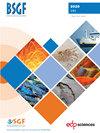德尔斐神庙的石头-科林斯湾北岸-希腊
IF 2.1
3区 地球科学
Q2 GEOSCIENCES, MULTIDISCIPLINARY
引用次数: 6
摘要
古希腊人选择什么石头建造高楼大厦至今仍是一个悬而未决的问题。如果当地材料的使用似乎是普遍的,那么通常也会出现异域石材,但会导致明显的额外成本。目前的工作旨在对德尔斐神庙中使用的石头的起源有一个详尽的了解。阿波罗圣所位于帕纳索斯带,位于与科林斯裂谷有关的大型正断层的上壁上,主要由石灰石、角砾岩、大理石以及更近的、在文献中被称为孔隙的较差固结沉积物组成。为了超越这种全球视野,考古遗址中使用的不同岩性已经被确定,以及当地的采石场,以找到它们的起源。不同的灰岩均为原生体,来自上侏罗统-白垩统的特提斯洋碳酸盐岩台地,与Hellenides造山带有关。帕那萨斯山的石灰岩构成了该遗址的大部分岩石体积;一种特殊的马斯特里赫特石灰岩被称为“Profitis Ilias石灰岩”,它被用于阿波罗神庙等更著名的建筑。相应的古代采石场位于保护区以西几公里处。然后,坡角砾岩在保护区中大量使用:它在遗址内和周围生长,并铺设在碳酸盐之上。最后,孔隙似乎变化很大,记录了7种不同的相,包括钙华、鲕粒岩、海相碳酸盐岩和粗粒砂岩。所有这些新近形成的相都存在于科林斯湾的东南岸,尽管除了颗粒岩以外,采石场还不为人所知。本文章由计算机程序翻译,如有差异,请以英文原文为准。
The stones of the Sanctuary of Delphi – Northern shore of the Corinth Gulf – Greece
The choice of stones by the ancient Greeks to build edifices remains an open question. If the use of local materials seems generalized, allochthonous stones are usually also present but lead to obvious extra costs. The current work aims to have an exhaustive view of the origins of the stones used in the Sanctuary of Delphi. Located on the Parnassus zone, on the hanging wall of a large normal fault related to the Corinth Rift, this Apollo Sanctuary is mainly built of limestones, breccia, marbles, as well as more recent poorly consolidated sediments generally called poros in the literature. To overpass this global view, the different lithologies employed in the archaeological site have been identified, as well as the local quarries, in order to find their origins. The different limestones are autochthons and come from the Upper Jurassic – Cretaceous carbonate platform of the Tethys Ocean involved in the Hellenides orogen. Those limestones of the Parnassus Massif constitute the majority of the rock volume in the site; a specific facies of Maastrichtian limestone called “Profitis Ilias limestone” has been used for the more prestigious edifices such as the Apollo Temple. The corresponding ancient quarry is located few kilometers west of the sanctuary. Then, slope breccia has been largely used in the sanctuary: it crops out in and around the site and is laying on top of the carbonates. Finally, the poros appear to be very variable and seven different facies have been documented, including travertine, oolitic grainstone, marine carbonates and coarse-grained sandstones. All these recent facies exist in the south-east shore of the Gulf of Corinth, although – except for the grainstone – the quarries are not yet known.
求助全文
通过发布文献求助,成功后即可免费获取论文全文。
去求助
来源期刊
CiteScore
5.80
自引率
0.00%
发文量
18
审稿时长
>12 weeks
期刊介绍:
BSGF - Earth Sciences Bulletin publie plusieurs types de contributions :
1. des articles originaux, couvrant tous les champs disciplinaires des Géosciences, à vocation fondamentale mais également à vocation plus appliquée (risques, ressources);
2. des articles de synthèse, faisant le point sur les avancées dans un domaine spécifique des Géosciences, qu''elles soient méthodologiques ou régionales ;
3. des monographies sur la géologie d’une région donnée, assorties d’informations supplémentaires, cartes, coupes, logs, profils sismiques … publiées en ligne en annexe de l’article ;
4. des articles courts de type « express letter » ;
5. des livrets-guides d’excursion (qui suivront le même processus d’examen éditorial que les articles plus classiques) ;
6. des comptes rendus de campagnes à la mer ;
7. des articles de données géodésiques, géophysiques ou géochimiques, pouvant devenir des articles de référence pouvant conduire à des interprétations ultérieures.
BSGF - Earth Sciences Bulletin constitue également un forum pour les discussions entre spécialistes des Sciences de la Terre, de type comment-reply ou autre. Tous les articles publiés, quelle que soit leur forme, seront accessibles sans frais (articles en Open Access) sur le site de la SGF et sur celui de Geosciences World dans la mesure où les auteurs se seront acquittés d’une contribution de (Article Processing Charges – APC) de 300€ pour les membres de la SGF et 500€ pour les non-membres.

 求助内容:
求助内容: 应助结果提醒方式:
应助结果提醒方式:


